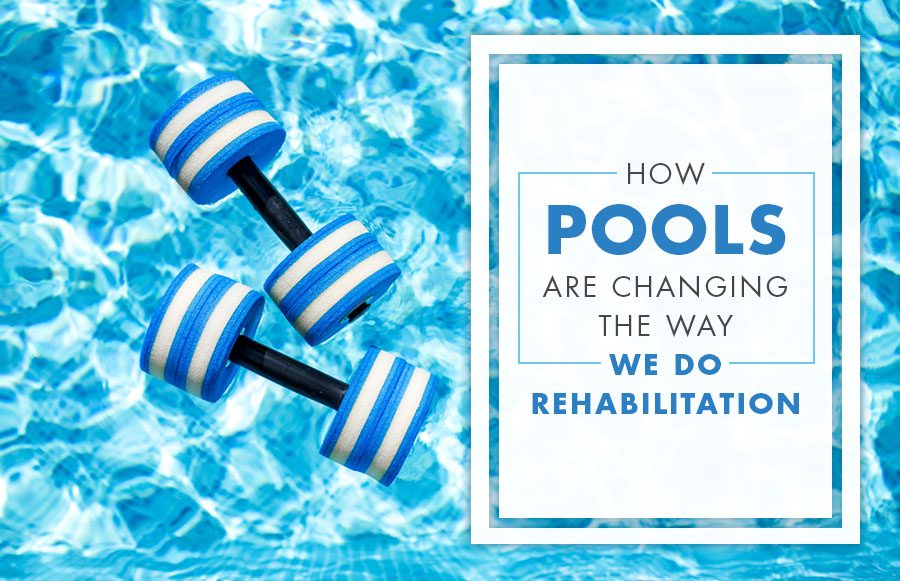
For centuries, people have recognized the value of water for healing purposes. At first, water was used to relieve muscle pain. It took immense physical work just to survive, and people discovered that the cool water of a lake, or even a stream, could ease their sore muscles. It didn’t take long to recognize that the cool water had the same effect on their farm animals.
People also discovered hot springs. The fact that the water was coming out of the ground and was hot even in winter often caused the people to give the hot springs a spiritual or magical power. Tribes would travel long distances every year to the hot springs. Eventually, the connection of hot springs to magic changed to a belief that the water of the hot springs had incredible healing powers and could cure almost everything.
Hot Spring Resorts Sprang Up
Resorts and elaborate facilities built up around the hot springs. Think about Bath in England. When you went to Bath to “take the waters,” you had the choice of entering the baths, which were large pools filled with the hot water, or you would drink the water.
Remember, in those days, a bath for cleaning yourself was done with water you heated on a stove. It was impossible to have more than a few inches of water. At Bath, your whole body was immersed in warm water. Imagine if you had suffered from arthritis and, for the first time, you had some pain relief from the heat of the water. It must have felt like magic!
Water Therapy for Healing
Today, we have controlled studies that have helped to determine when to use warm water and when to use cold water for the best results in healing. We can measure the results of training in different ways, such as jogging in water vs. jogging on a track. We are learning how to optimize the use of water in both fitness and in rehabilitation.
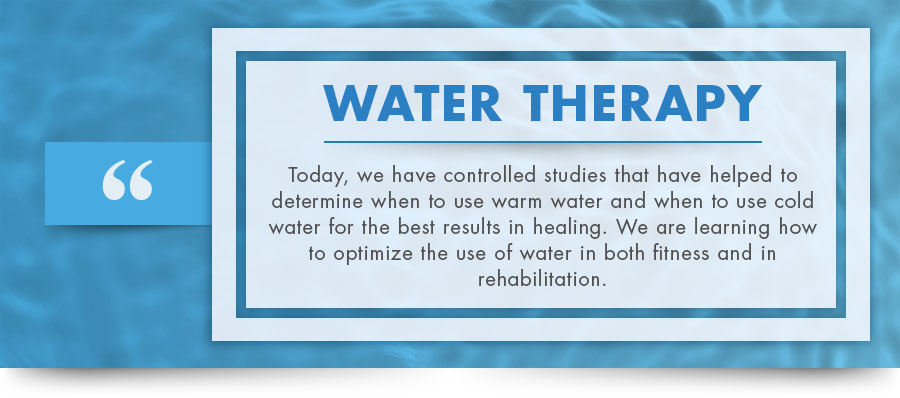
We are gaining a lot of knowledge from the trainers and sports medicine doctors. Their job isn’t just dealing with the aftermath of an injury or even just the wear and tear on the athlete’s body from participating in their sport. It is also about developing a training program that maximizes the athlete’s abilities and also helps the athletes by preventing injuries in the first place.
These are super elite athletes who put their bodies under extreme performance pressure. What is their training regimen? Is there a correlation between their off-season training and the number of injuries during the season? This is the type of knowledge we need to help the average person whose goal is lifetime fitness.
Two Forms of Water Therapy
Rehabilitation in the water can take two forms. Water therapy is treatment given by a licensed physical therapist who has had additional training in water therapy. The therapy is individual to the patient being treated and works with their strengths and weaknesses.
The pool is generally a plunge pool size and the water is heated. There are usually underwater cameras so the therapist can evaluate the patient’s movements and gait underwater and make adjustments to the therapy as needed. The therapy is always given one to one with an individual plan for each patient.
Covered by Health Insurance
Therapy is done with a physician’s order and is usually covered by your health insurance. The types of rehabilitation that could qualify for water therapy are strokes, arthritis, surgery, fractures, and many others. Water exercise is a lower level of treatment. While you should talk to your doctor before you start this type of rehabilitation, it can be done with or without a trainer. There are classes available in water exercising but you can do this in your backyard pool.
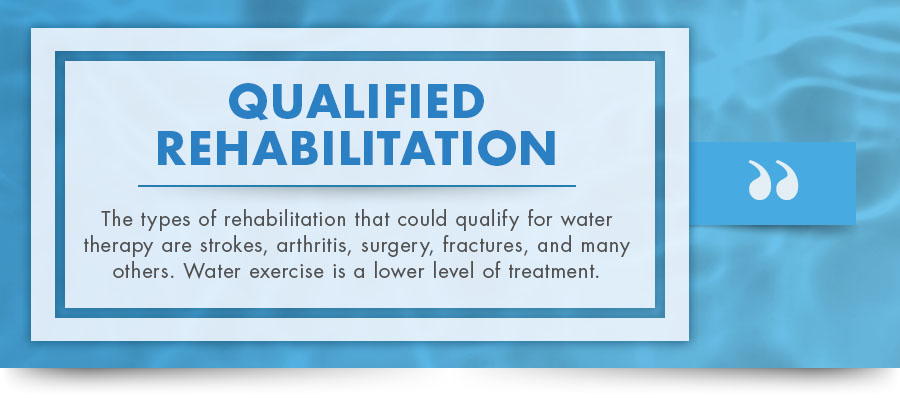
While we are making great strides in human rehab, we are also seeing a rise in water therapy for animals, especially dogs and horses. Even centuries ago, owners used to take their horses to the ocean to soothe injured legs and also for training to strengthen leg muscles. The farmers of the day used their horses like we use a tractor. These horses worked hard. They were also the only means of transportation other than walking. It was no wonder that the horse suffered sore muscles after pulling a plow or hay wagon all day.
Farmers soon learned that the cool water in the lake or river could soothe sore muscles and helped to relieve inflammation. Today, we don’t necessarily take our horses to the local pond, but we hose the horse down, concentrating on the leg that is bothering it. The problem is it takes about 20 minutes of hosing to make it effective.
Hot Tubs for Horses
Today, many horse owners and trainers are using a large tub that is about the size of a horse trailer. These specialty trailers have ramps at the front and back so the horse can be easily placed in the trailer for treatment. The horse is walked into the trailer, much as he would be when transported.
Once in the trailer, the door is closed and sealed, and water is added to the depth desired. There also can be jets that gently massage the horse. When the treatment is finished, the water is drained, the front door is opened, and the horse can walk out the front. Because it is designed to be similar to the transport trailer the horse is used to, the horse is not stressed or nervous about the tank.
Dogs Can Use Hot Tubs Too
Dogs are also being treated to water therapy for rehabilitation from injuries and/or surgery. Generally, dogs are given time on a treadmill that is submerged in water or they are accompanied in a pool and enjoy directed play with the handler.
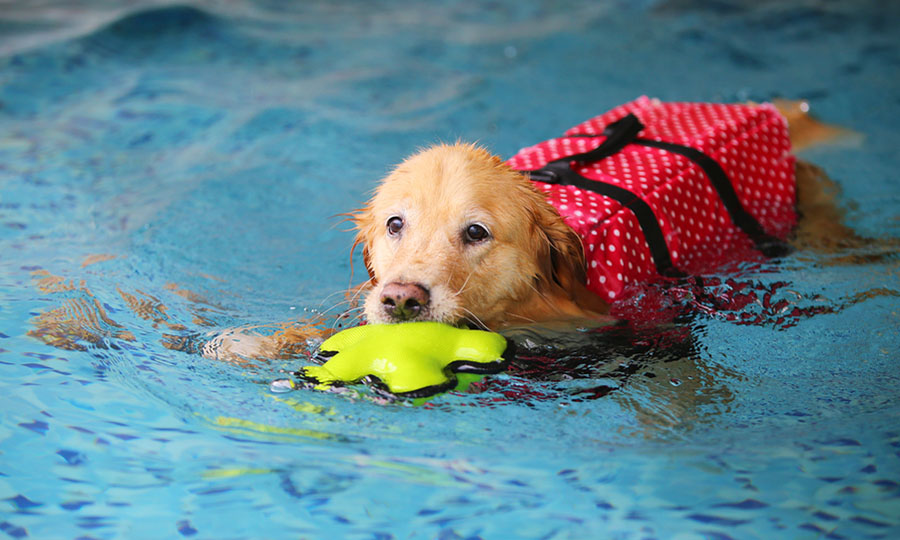
In the case of the treadmill tub, it is entered by the dog and then the water is added to the depth appropriate for the size of the dog receiving therapy. The treadmill speed can then be controlled from extremely slow to a brisk trot. The use of water allows the dog to walk in a low impact way.
If your dog is further in his recovery or he is receiving therapy for arthritis pain or fitness issues, he may receive pool therapy. In this case, the dog is accompanied into the pool by the handler and played with in a directed way. The dog should think he is just having fun, but the trainer is directing what the dog is doing.
For instance, if one side of the dog is weaker than the other, the trainer will be encouraging the dog to use that side more with the use of toys and treats. Both methods have been shown to speed up recovery––and in a way that is fun and stress-free for your dog.
So, how do people do rehab in the water and what can you expect to gain? Just as with a traditional land-based workout, always start with a warmup. This should include stretches of your arms and legs. Follow with your workout, concentrating on the area you are trying to rehab if needed. End with a cool down period.
Since you are outside, always apply sunscreen, and reapply every two hours while outdoors. Use sunscreen even on cloudy days. Don’t forget to drink plenty of water. Since you can’t see the sweat of a workout like you do in the gym, you may think you don’t need to drink fluids. You still need to stay hydrated, so don’t forget the water.
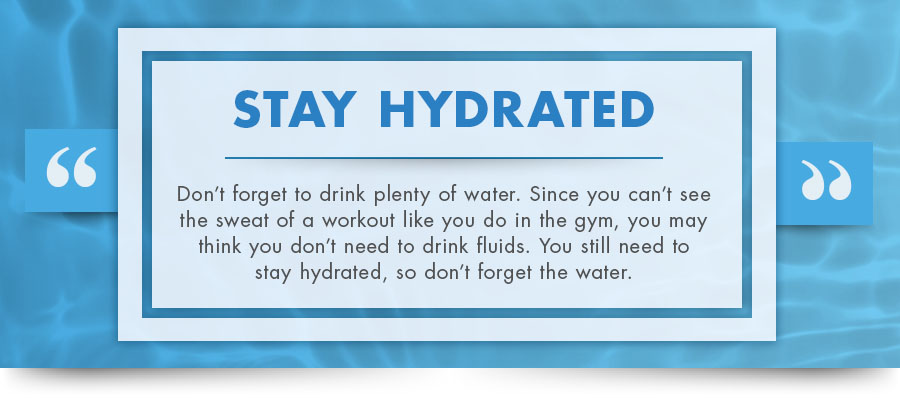
Your backyard pool workout can have a lot of advantages over the traditional land-based workout. Here are just a few reasons to add water to your rehab:
Lower stress. Studies have shown that stress levels in humans drops when we just look at the water. That’s why beach vacations are so popular, and people always come home saying how relaxing their vacation was. That effect is enhanced when we actually enter the water.
No fear. When you are recovering from a leg injury, it’s hard to trust your leg. The fear of falling because your knee gives out can make it difficult to exercise the way you should. If you have already fallen, the fear can be overwhelming. For some people, being in the water relieves that fear. Even if you lose your balance or your knee does give out, you won’t get hurt because you are in the water, not hitting the floor. You can add to your security by using floatation devices.
Low impact. The buoyancy of the water makes exercise in the water low impact. In other words, it is easy on your joints. This is especially important if you have arthritis or fibromyalgia or are recovering from an injury.
Resistance of the water. Pretty much anything you do in water, including exercise, will be more effective than the same move done on land. That is because the water provides resistance against the movement. That resistance will help your muscles develop and grow stronger.
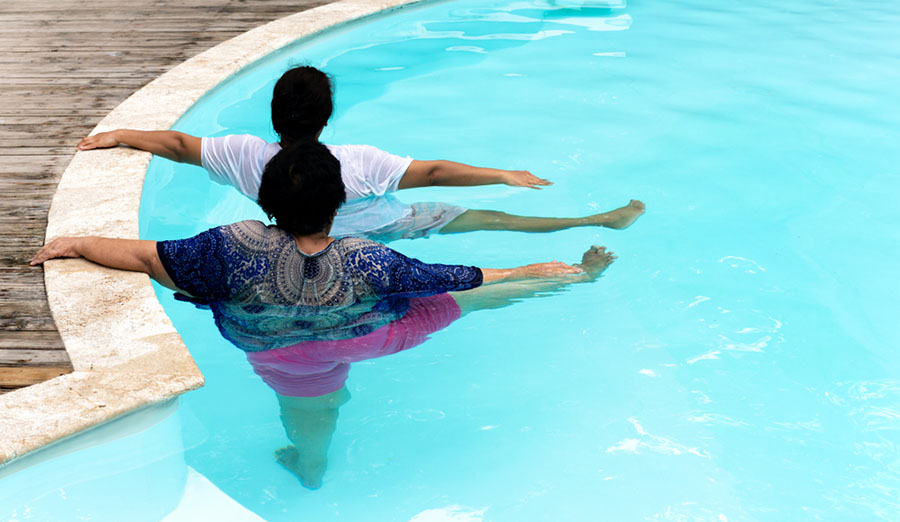
Fun. Pretty much any exercise done outside in your beautiful backyard pool is more fun than working on a mat in your bedroom. If you miss the camaraderie and encouragement from your gym mates, invite a couple friends to join you in your backyard pool.
Equipment. Today there is equipment available for purchase that will help you to rehab in your own pool. Check out the in-water treadmills and bikes. Aquacycling is very popular right now, and there is no reason not to add it to your routine. These treadmills and bikes are made out of marine-grade steel and will not rust or be affected by the pool chemicals or salt.
Exercise accessories. When you are ready to intensify your workout, add pool weights or webbed gloves. Webbed gloves are, as the name implies, gloves made with webbing between the fingers. This gives a greater area of resistance against the water, for a more intense workout of the arms. Just wearing these gloves, while swinging your arms forward and back as you walk in the water, will make a surprising difference in the energy required. Also, consider wearing pool shoes when recovering from an injury. The extra traction they provide will give you a little added security against slipping in the pool.
Low risk of injury. You are very unlikely to be injured while working out in a pool. This is partly due to the buoyancy of the water but also because it is low impact exercise.
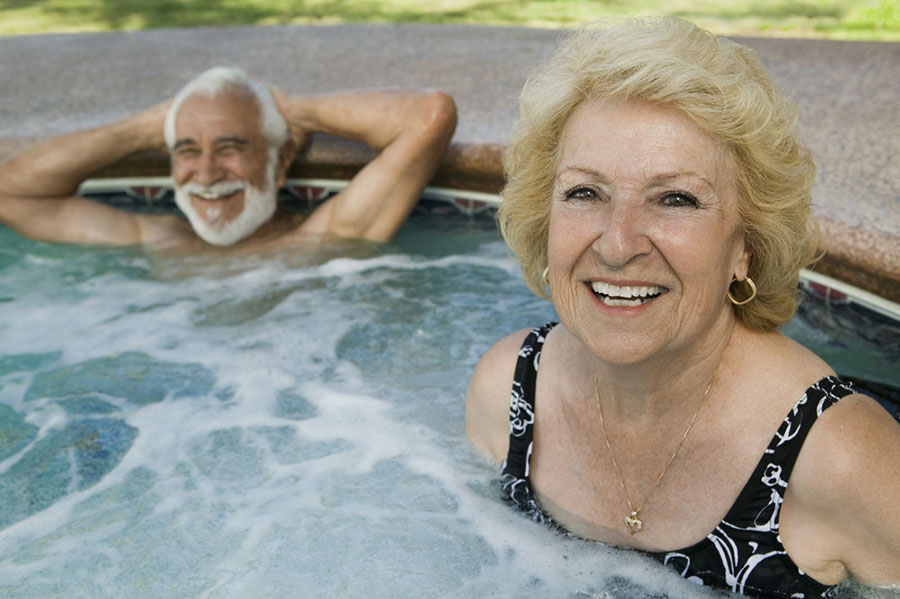
Flexibility. Flexibility is just as important as strength when talking about fitness. As we age, it is not unusual to lose some flexibility. The problem is that with the loss of flexibility comes a lessening of your range of motion and mobility, and this can lead to less coordination and a reduction of balance. What comes next? Falls. Water exercise can be very beneficial in improving flexibility. Warmer water is even better because it will help muscles to be relaxed and easier to stretch. You may want to use the hot tub, especially if you have chronic health issues like arthritis or fibromyalgia.
Cardiovascular benefit. Exercise, walking, or swimming laps in the pool are all aerobic activities. Anytime you engage in aerobic activity for more than 10 minutes, you are contributing to your heart health. Of course, always talk to your doctor before starting to work out in a new way.
Keep in mind that you can always increase the intensity of your workout by increasing the speed, the resistance, or the time spent. Walking in shallow water is easier than walking in deep water. Start slow, especially if you are in rehabilitation. Do not try to work through pain. Stop the exercise you are doing immediately. A little muscle soreness after working out is acceptable, but not pain––especially in a joint.
 Hello Guest,
Hello Guest,  0 item(s)
0 item(s)
